Blockchain Applications from the Perspective of Legal Persons: Taking the Judicial and Supply Chain Finance Fields as Examples
Hello everyone, I am Wang Lei, Legal Director of Wanxiang Blockchain. As a practicing lawyer specializing in the fields of financial law and corporate law, why did I choose to start a new career in such an area that is changing rapidly and the legal regulation is not very mature? I will tell you why with the picture below.
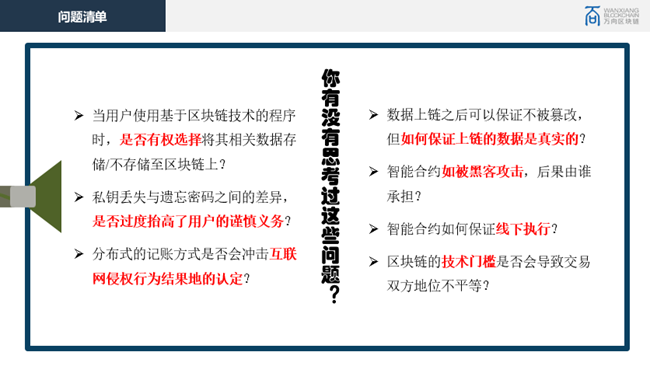
These questions were briefly sorted out when I was preparing this course content, and everyone can take a look first. I take the first question to further explain: When users use programs based on blockchain technology, do users have the right to choose whether to store their related data or not on the blockchain? If in the future, in the case that blockchain technology is widely used, most programs use blockchain technology. For ordinary users, is there such an option as to whether their own data is on the chain? Will the operator of the program give the user such authority at that time, or will the legislation at that time guarantee the user to enjoy such rights? This is just a primer. The questions on this picture are all related to the law, and some of them can't give a concluding point, but this is exactly why I am interested in the blockchain industry, because there are many such interesting legal issues that can Think and explore further.
Regulatory, policy and industry news in China
Let me introduce you to the context of today's course. In the first part, I will focus on the current domestic regulatory policies and industry news. The second part will briefly introduce the basic knowledge of blockchain. The third part is the application of blockchain technology, which also fits my theme today, law The application of blockchain in human vision will be divided into two parts: one is the application of blockchain in the field of justice, and the other is the application of blockchain in the field of supply chain finance. Let's first look at domestic regulatory policies and industry news.
- Analysis: Is there any real usage scenario for Bitcoin?
- Developing blockchain is an action to save the Internet?
- Depth: How far is the cryptocurrency ETF in the future?


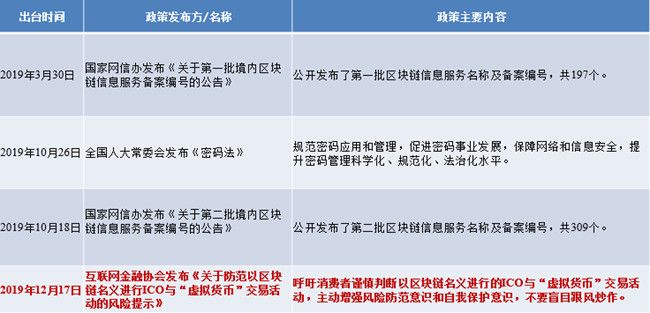
We have combed the national level regulatory policy on blockchain from 2013 to the present. I cannot say that it has been completely counted, but the main ones have been listed. A total of 12 can be seen. The first regulatory policy we have listed is the “Notice on Preventing Bitcoin Risk” jointly issued by the five ministries and commissions such as the People ’s Bank of China on December 3, 2013. In the first page of the PPT, I highlighted the central bank ’s September 4, 2017 After the seven ministries issued the "Announcement on Preventing the Financing Risks of Token Issuance", which is also known as the "94 Documents", after the 1994 Documents, various types of token issuance and financing activities were stopped in China. The organizations and individuals who have issued and financed tokens have been retired. This article is very important in the supervision of domestic blockchains.
Many people will ask, what can be done in the field of blockchain in China? What cannot be done? Before there are more written regulatory policies, we need to study and explain how those documents have been published before, what can be done and what can't be done. My focus today is related to blockchain applications. On January 10, 2019, the Cyberspace Office issued the "Regulations on the Management of Blockchain Information Services." Some people believe that the era of formal supervision of the blockchain has come. This article is strongly related to applications. I will analyze the key provisions later.
We can see a trend from the table. After the "Regulations on the Management of Blockchain Information Services", the national level did not publish any articles related to ICO or tokens. Until December 17, 2019, the Mutual Fund Association released the " Regarding the precautionary measures to prevent the risk of ICO and virtual currency transaction activities under the name of blockchain, consumers are called to judge carefully the ICO and "virtual currency" transaction activities under the name of blockchain. We speculate that this is mainly because of October 24 After General Secretary Xi Jinping delivered an important speech on blockchain technology, a number of projects came out in the name of the blockchain, and some even did some bad behavior. The text of the Mutual Fund Association at this point The role of reminders and alerts.

After reading the regulatory policy, let's look at the favorable policies. As of today, a total of 28 favorable policies have been issued at the national level. We have made this picture according to the time and main body of policy promulgation.It is not difficult to see that 2019 is the peak period of favorable policy. The other subjects are mainly related to various fields including supply chain, education, transportation, postal services, and logistics. You can pay attention to them according to your industry.
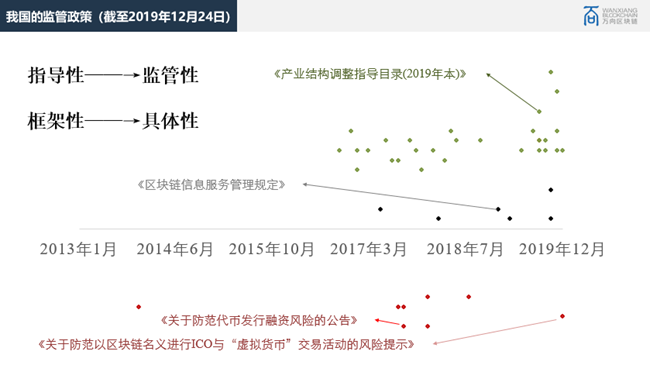
This is a simple diagram, to give you a relatively macro concept, combing on the time axis. From 2013 to 2019, about 40 texts, each dot represents a different text. Above the horizontal axis is distributed the blockchain technology-related supervision (black logo) and favorable policies (green logo), below Distributing are regulatory policies related to ICOs or tokens (marked in red). Through this chart, I have summed up a point for your reference: domestic regulatory policies have a tendency to change from guiding to regulatory. The previous articles are more framed, and now they are more specific and easier to operate according to regulations. As early as 2013, bitcoin was noted at the national level, but it was not until 2016 that the Ministry of Industry and Information Technology issued the "China Blockchain Technology and Application Development White Paper", which marked that the national level began to pay attention to the development of blockchain. In 2019, blockchain technology has become the focus of attention, and favorable policies have shown a spurt of growth that supports both the two-pronged approach to standardization, thereby leading the blockchain industry to develop in a more compliant and sustainable direction.
In the favorable policy marked by green, I highlight the "Industrial Structure Adjustment Guidance Catalogue (2019 Edition)". If you have followed this article, you will know that at the time, a draft of the comments was issued, and the virtual currency was "mining." The entry was included in the eliminated industries, but when the official text was released, this article was deleted from the eliminated industries. In addition, the industry was encouraged to include "big data, cloud computing, information technology services, and the scope allowed by the state. Blockchain information service. " The regulatory policy marked in black highlights the "Regulations on the Management of Blockchain Information Services". This article has already been mentioned before and will not be repeated here. The red marks are related to the regulatory policies related to tokens and ICOs. Two texts are highlighted, one is the 94 text, and the other is the latest text of the Mutual Fund Association on December 17, which was also mentioned earlier.
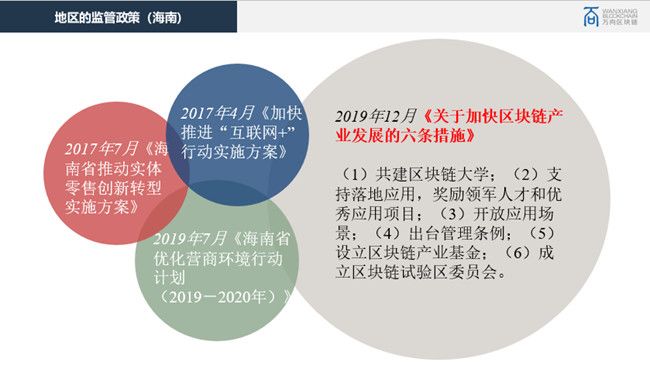
After reviewing the regulatory and favorable policies at the national level, I will focus on clarifying the regulatory policies at the two regional levels. The first is Hainan, which everyone may pay attention to. In November this year, the Ministry of Industry and Information Technology issued the "Implementation Plan for Supporting the Construction of a Free Trade Pilot Zone in Hainan and a Free Trade Port with Chinese Characteristics". The plan proposed 17 projects including supporting the development of the blockchain industry in Hainan. Then in December, the Digital Civilization Conference hosted by the Hainan Blockchain Pilot Zone announced the "Six Measures on Accelerating the Development of the Blockchain Industry" (referred to as "chain six"). These six measures are aimed at solving talents, scenarios, technologies, The bottleneck of blockchain development such as capital has attracted leading blockchain companies and research institutions to settle in Hainan, and encourages universities and research institutions under the Ministry to build a state key laboratory of blockchain technology in Hainan.

Another province to mention is Zhejiang, which was one of the earliest provinces to deploy blockchain. Among the two registered blockchain application projects, Beijing ranked first with 150 homes, Guangdong ranked second with 130, Zhejiang ranked third with 77 homes; and Zhejiang also has many well-known blockchain companies, such as Ant Blockchain. , FunChain Technology, etc., these cannot be separated from government-level support. Zhejiang Province proposes to make the blockchain industry a future industry, giving preferential treatment in terms of talents, land, infrastructure, government subsidies, scientific research support, etc .; in addition to encouraging policies, Zhejiang Province also attaches great importance to supervision. The “Regulations on the Management of Blockchain Information Services” implemented by the Credit Office corresponded to the “Implementation Opinions on Strengthening the Management of Blockchain Information Services”, and proposed that “blockchain information service providers who have completed filing 16 regulations such as the record number of Internet sites, applications, etc. that provide services to the outside world are prominently displayed.
Next is industry news. I mainly sort out news related to the blockchain industry in the judicial field. On October 24, 2019, General Secretary Xi Jinping emphasized at the 18th Collective Learning Conference of the Political Bureau of the CPC Central Committee that "Take blockchain as an important breakthrough in independent innovation of core technologies and accelerate the development of blockchain technology and industrial innovation." This is a great encouragement to the entire industry of the blockchain and the practitioners in the industry. The Fourth Plenary Session of the 19th CPC Central Committee from October 28 to 31, 2019 adopted the "Central CPC Central Committee's Decision on Adhering to and Perfecting the Socialist System with Chinese Characteristics, Promoting the Modernization of the National Governance System and Governance Capability," and added " "Data" as a factor of production. Regarding data, the country has recently introduced quite a few measures, especially for web crawler companies. This also illustrates from another level that from the country to the individual, people are beginning to realize the importance of data, and blockchain technology can make data And the value of data returns to the individual maximally.
On November 8, 2019, President Zhou Qiang presided over the second plenary meeting of the Leading Group of Cyber Security and Informatization of the People's Court in 2019, emphasizing the implementation of General Secretary Jinping's practice at the 18th collective learning meeting of the Political Bureau of the CPC Central Committee. Important speech spirit, strengthen the application of blockchain and artificial intelligence in the field of justice; in fact, quite a few courts have explored and implemented applications in the field of blockchain applications, which will be described later in detail.
On November 16, 2019, Minister Fu Zhenghua attended the "Blockchain + Rule of Law" forum and pointed out that the Ministry of Justice and the entire system must seize opportunities, actively promote the full integration of blockchain technology and the rule of law, strengthen study and research, and strive to improve Blockchain technology management and application capabilities, "blockchain + rule of law" as a new content of "digital rule of law, smart justice" construction.
The content I share today covers so much industry news, mainly considering that when a technology is to be combined with legislation, people who first formulate and practice laws need to understand this technology. At least the attitude is positive, think To know what a blockchain is, it is only after knowing that there are more possibilities for acceptance and embrace. These industry news, in my opinion, can enhance the confidence of our legal people in this field.
Blockchain basics
Regarding the definition of the blockchain, I chose the definition in the ISO 22739 standard document, "Blockchain is a distributed ledger in which blocks that are confirmed by consensus are added in order using cryptographic technology." In order to help everyone understand better, I have selected a sentence summary from the series of popular videos of Wanxiang Blockchain. "Blockchain technology is a system that allows all parties in the system to cooperate and maintain a reliable record through the use of cryptography in an environment where multiple parties do not need mutual trust. Way of data logging. "
Different people have different understandings of the blockchain, and their emphasis is different; just like The Economist emphasizes that the blockchain is a trusted machine, Li Lihui, former president of the Bank of China, believes that the blockchain has established a "technology The "endorsement" trust mechanism uses technology trust to increase business credit, and Professor Zhang Shousheng's point of view is In Math We Trust. Here, I want to share with you the perspective of Wanxiang Blockchain, In Blockchain We Trust. The legal body of the Wanxiang blockchain was established in January 2017. At that time, most people had almost no concept of the blockchain, and we had to convey a belief to everyone through the Slogan of the Wanxiang blockchain. First, We believe in blockchain and we firmly explore it in practice. Second, we hope to create a trusted world through blockchain technology.
Application scenarios and legal services of blockchain technology
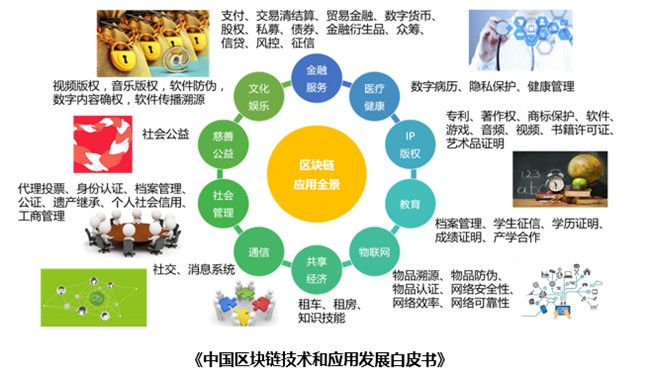
Next is today's main link, application scenarios of blockchain technology and legal services. This picture is from the "China Blockchain Technology and Application Development White Paper". I believe that everyone is no stranger. When different people look at this picture, they should see different information. When I look at this picture, in addition to feeling that blockchain applications can be involved in so many aspects, I will think more about how to enter the market as a legal person? In which applications can legal services be provided? Is it easier to provide legal services in financial services? If yes, what legal services are available? Or is there more legal services in IP and copyright? With so many dimensions, today I only pick two points to develop, one is the judicial field and the other is the supply chain finance field.
Blockchain + justice
The implementation of blockchain technology in the judicial field is faster than everyone thinks. The "balance chain" of the Beijing Internet Court should not be unfamiliar to everyone. It focuses on solving the problems of electronic evidence deposit and on-line evidence inspection. At present, 18 cross-link into the blockchain node have been completed, and the amount of cross-chain deposit evidence data has reached Hundreds of millions. The Guangzhou Internet Court launched the “Netcom Legal Chain” electronic evidence system in March 2019. All nodes on the chain are courts, procuratorates, judicial bureaus, notary offices, arbitration commissions and other judicial institutions. Hangzhou Internet Court has adopted an open and neutral attitude in case analysis and determination of electronic data that is stored and fixed by using blockchain and other technical means. The judicial blockchain it developed has been launched, including blockchain programs and blockchain. The three layers, the full link capability layer and the judicial alliance layer, solve the generation, storage, dissemination, and use of the entire life cycle of electronic data on the Internet through the overall structure, especially the credibility of the entire process of the generating end. Xinhua News Agency, Youku, Alibaba and other 19 institutions or enterprises.
In the judicial field, I have selected two application cases. The first is the implementation of one-click filing by the Beijing Internet Court using blockchain smart contract technology . Let's take a look at the case review: In a network infringement dispute case, the plaintiff and the defendant conducted mediation under the auspices of the court and reached a mediation agreement. The mediation agreement required the defendant to pay the plaintiff's compensation of 33,000 yuan by October 16, 2019. The court has informed both the plaintiff and the defendant that if the defendant fails to fulfill his obligations during the performance period, he will implement automatic execution through blockchain smart contract technology. After the mediation statement came into effect, the words "smart contract" appeared on both the client side and the judge side of the case to distinguish it from ordinary cases. On October 17, the defendant still had 20,000 yuan of compensation unfulfilled; the plaintiff clicked the "Not Completed" button, and the case went directly to the filing case of the Beijing Internet Court's filing court; after passing the review of the filing court, the filing was successful and entered the enforcement system .
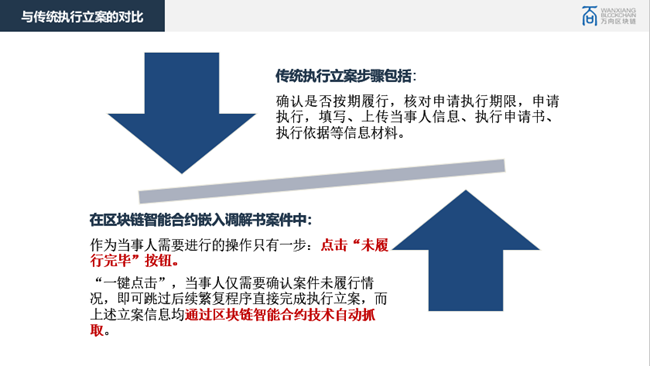
The traditional execution of the case registration process includes confirming whether to perform on time, checking the application deadline, applying for implementation, and filling in and uploading various information materials. The steps are complicated, and the parties need to fill in and submit more materials. Compared with this case, the blockchain smart contract is used. Embedded in the mediation statement, the parties can simply click on the case according to the performance of the case, and then skip the subsequent complicated procedures to complete the execution of the case directly. The case registration information is automatically captured through the blockchain smart contract.
Let's take a brief look at smart contracts. The concept of smart contracts was first proposed by Nick Saab in 1994. It is a set of commitments defined in digital form, including agreements on which contract participants can implement these commitments. Smart contracts include three elements of decentralization, autonomy, and self-sufficiency. Autonomy refers to the automatic operation of a contract without any intervention from its initiator.
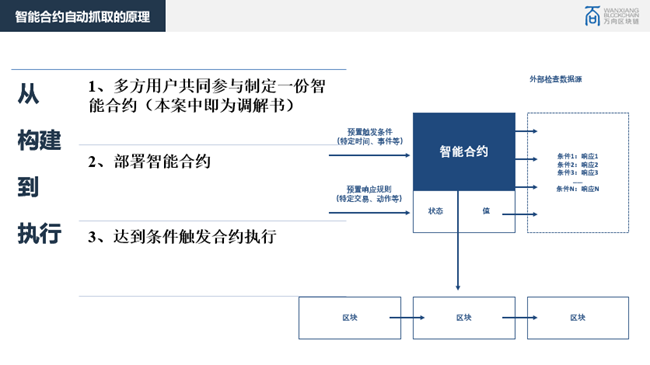
Let's return to the case, and everyone will ask, where is the principle of automatic capture through smart contracts? In simple terms, it is a preset trigger condition or response rule. In this case, the defendant told the plaintiff's compensation payment obligation of RMB 33,000 before October 16, 2019, as agreed in the mediation statement. It is deployed on the blockchain; after the defendant's compensation is still not fulfilled on October 17, and the plaintiff correspondingly clicks, the contract is automatically executed.
So, what are the advantages of smart contracts in the judicial blockchain? In summary, four points: to break through the limitations of language, promote intelligent implementation, reduce the burden and increase efficiency of case handling, further promote the speedy execution of simple cases, the stubbornness of difficult cases, and the convenience of justice. As legal persons, we will compare smart contracts with traditional legal contracts. My personal point of view is that each has its advantages and disadvantages. Today, I will not discuss this topic, but only focus on the first point of "breaking the limitations of language". I will provide you with One idea, because the smart contract uses computer code, it is precise and unique. It can avoid misunderstanding between the two parties due to language loopholes. As mentioned in the case before October 16, 2019, the defendant should pay the plaintiff 33,000 yuan, triggering conditions. Clear; but in the course of business, if we need to deal with a framework contract or strategic cooperation agreement, when the rights and obligations have not been clear, the two parties need to negotiate and discuss in a friendly scope, how should we code at this time? How to embed smart contracts?
Let's look at the second application case. Shanghai Second Intermediate People's Court adopted blockchain technology to realize intellectual property preservation . What is property security? Property preservation refers to the court's compulsory measures to restrict the disposal or transfer of property in accordance with relevant applications in order to ensure that future effective judgments can be effectively implemented, or in order to avoid the irreparable damage to the interests or the legitimate rights and interests of parties in a timely and effective manner . So, what problems will traditional property preservation encounter? 1. The guarantee provided by the applicant needs to be manually verified by the court, resulting in a long process time for application procedures; 2. The information feedback is slow, and it is necessary to call or inquire on the spot, and it is difficult to check the progress of the security; Docking the contract officer; 4. The insurance business personnel's tearing or burying the bill caused the guarantee letter to be invalid or false.
The official display of this application case is less. We have transcribed a short demo video through the "Shanghai Court 12368" applet. When the party or its agent enters the Shanghai Mobile Micro Court system, click the "Apply Security" interface, and it will pop up to fill in "Guarantee number" and other information interfaces, and after the parties fill in relevant information as required and upload it to the platform, the platform will automatically verify the authenticity of the guarantee and send the result to the court in one click.
The court uses blockchain technology to upload the guarantee data of various insurance companies to avoid the possibility of tampering. The contractor can access the relevant data by entering the guarantee information through the system and link it to the electronic file of the case. The acceptance information is immediately fed back to the insurance company, connecting the parties, guarantee institutions, and courts, so that the applicant can quickly go through the security formalities and get feedback in a timely manner.
Blockchain + Supply Chain Finance
Before starting to talk about legal services in the field of blockchain + supply chain finance, let me briefly talk about a few concepts about supply chain finance. What is supply chain finance? In a nutshell, supply chain finance is based on the real trade situation from the beginning to the end of the supply chain, and uses the determinable future cash flow generated by trade as the source of direct repayment. What industry pain points does the traditional supply chain financial model face? 1. Fraud risk (when warehouse receipts, bills are faked, etc.); 2. Island of corporate information (systems are not interoperable with each other, trade information mainly relies on paper documents); 3. Core corporate credit cannot be passed across levels (core corporate credit Can only be passed to first-tier enterprises, other suppliers cannot use core corporate credit for supply chain financing); 4. High compliance risk (constrained by contract alone, the use of funds and repayment by the financing enterprise is uncontrollable). Why does "blockchain + supply chain finance" receive widespread attention? Combining the aforementioned pain points in the industry, in short, because blockchain technology can guarantee the security, anonymity, and unmodifiability of information, and also takes into account the security guarantee and efficiency improvement of financial business requirements, so "blockchain + supply "Chain Finance" inevitably became the focus.
Wanxiang Blockchain has also conducted extensive and in-depth explorations in the field of supply chain finance, and has already landed applications and achieved profitability. In 2019, Wanxiang Blockchain cooperates with Jiangxi Bank, Zhengbang Technology and its suppliers. Zhengbang Technology and its subsidiaries will move their supply chain business processes to Wanxiang Blockchain's supply chain financial platform to improve business efficiency. At the same time, costs are saved. At the same time, the platform also introduces financial institutions such as Jiangxi Bank. Relying on the two core technologies of "supply chain + blockchain" and the credit transfer of Zhengbang Technology, it provides financial services for more small and micro enterprises. As of December 2019, a total of more than 250 million companies have been financed.
As a legal supporter, when you need to provide services for such a blockchain-based supply chain financial service platform, what specific issues may be involved?
Question: How to effectively restrict the rights and obligations of each participant? How is the "permission" in the alliance chain reflected in legal documents?
We borrowed the concept of alliance autonomy in the blockchain, and drafted the charter and supporting operating rules for the platform. Through the charter, we defined the role identities of the participants of the platform, clearly agreed on the behavioral consequences of each role, and the corresponding operation permissions. And rights and obligations, and what kind of operations can be exempted, and under what circumstances need to bear legal consequences; users who are willing to join and use the platform services, as long as they sign the platform charter, they are deemed to agree to this series of agreements and rules; we do not Participating companies agree on rights and obligations based on platform roles.
The alliance chain is a concept of permission or admission. For a blockchain-based supply chain financial service platform, we will reflect it by setting up "confirming the subject's qualification of the applicant" in the charter. How to confirm the subject qualification of the applicant? According to the classification of the application subject, the required auditing information is provided and passed the auditing process; companies and individual industrial and commercial households, financing supplier companies, core enterprises and financial institutions are required to provide different auditing information and need to be defined separately .
Question: How to reflect "user data protection" in legal documents?
As the awareness of data sovereignty rises, this issue is important. In the articles of association and operating rules, we have agreed on three main aspects: first, the obligation of confidentiality, the participants of the platform have the obligation to keep confidential the confidential information of other entities they learned during the use of the platform services, The confidentiality obligations assumed by different roles may be different. The second is to upload data, one of the features of the platform. Key business data on the platform or specific data required by users are uploaded and transferred after being encrypted. As a service provider, Wanxiang Block The chain cannot obtain the aforementioned data information, and the user's critical or sensitive business data is in the hands of the user; the service provider can determine the storage location of the user's specific data based on the principle of strictly protecting the user's sensitive data information from being leaked, but cannot obtain the user's specific data The third is the access right. It is not that the two parties can view all the data of the counterparty when they have business transactions on the platform; each participant of the platform has the right to view the data related to it or obtain valid authorization from other data holders. Case, view authorized data information.
Question: As a service provider of blockchain technology, what else will be involved?
Blockchain information service filing. On January 10, 2019, the Cyberspace Office issued the "Regulations on the Management of Blockchain Information Services", which will be implemented from February 15, 2019; it aims to clarify the information security management responsibilities of blockchain information service providers, standardize and promote the area The healthy development of blockchain technology and related services, avoiding the security risks of blockchain information services, and providing effective legal basis for the provision, use, and management of blockchain information services.
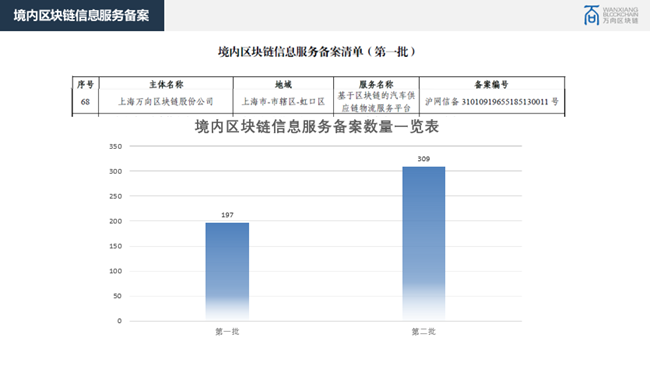
After the "Provisions" came out, the Cyberspace Office successively announced two batches of blockchain information service names and filing numbers. The first batch was announced in March 2019, a total of 197. We mainly promoted the blockchain-based The automotive supply chain logistics service platform project is also the first batch of records, the serial number is No. 68; the second batch was announced in October 2019, a total of 309.
In response to the Regulations, I will explain a few key points:
The first is keyword interpretation. A more important keyword, "Blockchain Information Service": Article 2 (2) of the "Provisions" states that the term "blockchain information service" as used in these Provisions refers to the use of blockchain technology or systems based on Internet sites and applications. To provide information services to the public. Then, the bottom layer uses blockchain technology for development, and externally providing information services in the form of websites or applications will fall into the definition and be subject to regulations. "Blockchain Information Service Provider": Article 2 (3) of the "Provisions" states that the "Blockchain Information Service Provider" referred to in these Provisions refers to the subject or node that provides blockchain information services to the general public, and The institution or organization that provides technical support for the main body of the blockchain information service. Here, the definition of "blockchain information service provider" is broader, and the "institutions" and "individuals" commonly used in general legislative technology are expanded to "subjects", "institutions" and "organizations", and blockchain The unique "node"; in addition, the institution or organization that provides technical support for the subject is defined as the subject of jurisdiction, which directly corresponds to a part of the blockchain project model of "subject to the sea, domestic technical support".
Followed by regulators. The "Regulations" specify that the Internet Information Office of the country and provinces, autonomous regions and municipalities directly under the Central Government is the competent authority for blockchain information services.
Again, regulatory requirements. On the one hand, the "Regulations" implement the main responsibility of blockchain information service security, including six levels: 1, the information content security management responsibility of information service providers. Article 5 proposes general requirements, but lacks the standards of the implementation system; however, information dissemination at the level of the alliance chain is relatively controllable; 2. Information service providers should have specific technical conditions. The "applicable technical conditions" and "international relevant standards and standards" referred to in Article 6 lack clear targets, but many group and industry standards have been implemented. The Ministry of Industry and Information Technology has also participated in the guidance and preparation of some standards. You can refer to them. 3. The information service provider shall formulate and disclose management rules and platform conventions. Compared with most legislators who lack knowledge of blockchain technology, industry personnel are more likely to capture the risks and legal loopholes that blockchain technology may bring. The establishment of the platform convention can better promote the healthy development of the industry, and it is also a legal requirement. The best supplements; 4. Authentic identity information authentication; 5. Blockchain information services shall not be used to engage in illegal activities or to produce, copy, publish, and disseminate prohibited information content; 6. To areas that violate laws, administrative regulations and service agreements Blockchain information service users should adopt disposal measures in accordance with the law and contract. On the other hand, blockchain information service providers should fulfill their filing obligations in accordance with the "Regulations." In addition, the "Regulations" have also made corresponding requirements on blockchain information service providers in three aspects: performing security assessments, rectifying security risks, and cooperating with supervision and inspection.
Finally, there are penalties. The punishment measures detailed in the "Provisions" include warnings, ordering suspension of services, rectification within a time limit, closure of services, and fines of less than 30,000 yuan, and those who constitute a crime shall be investigated for criminal responsibility in accordance with law.
Finally, I would like to mention a few compliance difficulties with the "Regulations", and welcome everyone to further discuss: 1. There is a conflict between the "irreversible" of blockchain technology and the right of correction and deletion granted by users. The "Regulations" are not clear How to deal with it? At the same time, the "distributed" characteristics of blockchain technology will also greatly increase compliance costs; 2. Most blockchain projects use open source technology, which may cause the identity of network participants to be multiple, which may lead to multiple identities. The boundaries of the division of security responsibilities are relatively vague; 3. There are many regulatory requirements for the platform, but there is no corresponding law enforcement procedure, and how can the platform's rights be guaranteed in practice.
The above is my sharing today, thank you all!
The author of this article is the legal director of Wanxiang Blockchain Company. This article is the author's personal opinion and does not represent the position of the unit.
We will continue to update Blocking; if you have any questions or suggestions, please contact us!
Was this article helpful?
93 out of 132 found this helpful
Related articles
- Blockchain changes 2020: start business without “bringing funds into the group”
- Blockchain is used for the first time to gather the five blessings: What is the experience of “blessing” sharing on the chain?
- Efficient Market Hypothesis and Bitcoin S2F Model: Prediction of Bitcoin Value
- Paper invoices that are disappearing: from 10,000 to 20, blockchain technology blesses electronic invoice reform
- Zhongxiang Internet won the A + round investment of listed company Jihong, with a valuation of 105 million yuan after the investment
- Opinion | Zhang Yifeng, Dean of China Banking Technology Institute: Do not think Libra will land soon
- 8 asked text version | Conflux Long Fan: Only by reducing the interaction cost with the public chain will there be more applications






